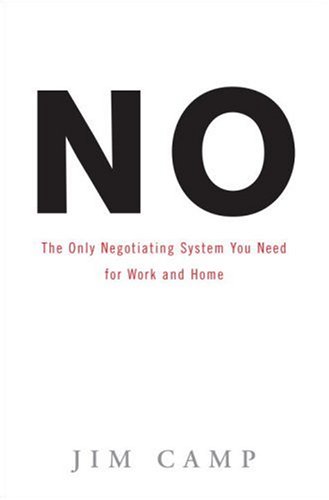I started reading “No” about a year back and I have been re-reading and re-re-reading and … it ever since. Now I don’t want to be Jim Camp’s (the author) booster but to say that this is one of the best business book ever written – is not hyperbole but an understatement. Now I have read a lot of books on negotiations – starting with the business school classic “Getting to yes”, “Negotiating rationally”, “When push comes to shove” and on and on but “No” gets to the real problem with negotiations – which is out of control emotions. The difference between books like “Getting to yes” and “No” is the difference between rational-agent economics (theory based on unrealistic assumptions) and behavioral economics (reality).
Jim Camp, the author, was once a pilot, so its no surprise that a of things he talks about are organized around check-lists and training. The book is really accessible, almost an easy read but it is also one of those rare books that has layers of insights that come into focus upon second or third or more readings.
The first chapter introduces the concept of “neediness” – the real killer in negotiations. It could be need for approval, need to save the relationship or fear of losing a customer. Most of the times, neediness is really because of our social conditioning or a flawed vision of self. To be a good negotiator one must give up neediness. Its ok to “want” a deal but remember you don’t need this deal – or much for that matter.
The book talks about resistance to “No” and how saying “No” is really key to managing your emotions and getting to a good deal. I have worked with many sales people who would never say “No” because “No” is the end, its defeat, its crashing of dreams but Jim explains that “No” is just the beginning, the foundation of any good negotiation. Jim explains that “No” is just a decision in the process and like just flying, you need to focus on the next decision.
One of my favorite chapters is how best to prepare for negotiations. The chapter focusses on how to create a mission and purpose that is rooted in the world of the other party. Having a mission and purpose that is focussed on the other party, helps keep your neediness in control and provides a roadmap for negotiations.
Another great chapter is about asking questions to build vision. As you know, its hard to tell anybody anything. A good way to build vision and drive the process forward is to ask questions that let people see their own problems and potential solutions for themselves. Asking question is another way to reduce the number of words you say – another great step to control your neediness.
There are several interesting ideas and checklists in the book:
- Find a way to be human – being human lower barriers and increases people’s receptiveness to the vision you are trying to build
- Repeat important things 3 things – If you heard Trump speak – he always repeats the key points 3 times or more (this is not an endorsement of Trump but an acknowledgement of his skill in the influence business)
- Be wary of conversations getting too positive or too negative
- How to create an agenda that can drive a negotiation – everything important should be on the agenda and so should be any baggage that might be the unspoken roadblock in your negotiation
- How to get to decision makers and bypassing the gate-keepers
Overall this is one of the best business books. If you haven’t read it, do yourself a favor and read it. Let me know if you agree with my flowery review…

Great Review!
Hi Dude – What is the reference to the number game in the book? Is it about focusing on process and not on results?
Indeed – That is exactly what its about – focus on behavior not outcome